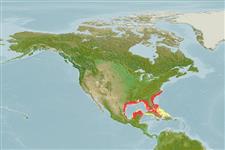Environment: milieu / climate zone / depth range / distribution range
Ecology
Marine; brackish; demersal, usually 11 - 13 m (Ref. 58018). Subtropical; 37°N - 19°N, 98°W - 70°W
Western Atlantic: North Carolina, USA to Cuba, and around Gulf of Mexico to Texas, USA.
Size / Weight / Age
Maturity: Lm ? range ? - ? cm
Max length : 30.0 cm TL male/unsexed; (Ref. 26340)
Found from bays and estuaries to the mid-shelf.
Life cycle and mating behavior
Maturity | Reproduction | Spawning | Eggs | Fecundity | Larvae
Robins, C.R., R.M. Bailey, C.E. Bond, J.R. Brooker, E.A. Lachner, R.N. Lea and W.B. Scott, 1991. Common and scientific names of fishes from the United States and Canada. Am. Fish. Soc. Spec. Publ. (20):183 p. (Ref. 3814)
IUCN Red List Status (Ref. 130435: Version 2024-1)
Threat to humans
Harmless
Human uses
Fisheries: commercial
Tools
Special reports
Download XML
Internet sources
Estimates based on models
Preferred temperature (Ref.
123201): 23.4 - 27.8, mean 26.5 °C (based on 341 cells).
Phylogenetic diversity index (Ref.
82804): PD
50 = 0.5000 [Uniqueness, from 0.5 = low to 2.0 = high].
Bayesian length-weight: a=0.00525 (0.00223 - 0.01237), b=3.13 (2.92 - 3.34), in cm total length, based on LWR estimates for this (Sub)family-body shape (Ref.
93245).
Trophic level (Ref.
69278): 3.6 ±0.6 se; based on size and trophs of closest relatives
Resilience (Ref.
120179): Medium, minimum population doubling time 1.4 - 4.4 years (Preliminary K or Fecundity.).
Fishing Vulnerability (Ref.
59153): Low vulnerability (20 of 100).
Nutrients (Ref.
124155): Calcium = 118 [57, 252] mg/100g; Iron = 1.25 [0.67, 2.29] mg/100g; Protein = 16.8 [14.5, 19.7] %; Omega3 = 0.388 [0.179, 1.038] g/100g; Selenium = 29.5 [14.4, 66.8] μg/100g; VitaminA = 23.5 [9.7, 59.1] μg/100g; Zinc = 0.913 [0.617, 1.331] mg/100g (wet weight);
